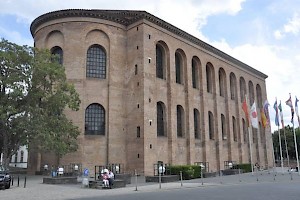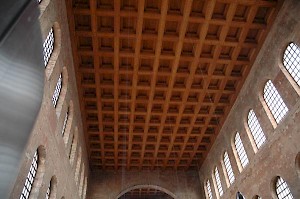Trier, Basilica
Q686773Augusta Treverorum: important Roman city, modern Trier.

The Aula Palatina or Basilica was added to the imperial palace by Constantine I the Great, who took over Trier as his residence from his father Constantius I Chlorus. The tiles were made by two men, Capio and Adiutex, who also produced the tiles for the slightly older Roman fort at Köln-Alteburg.

Although it is now used as a church, the interior of the basilica closely resembles an ancient basilica. The many windows - part of the painted decoration survives - add to the feeling of spaciousness. The roof and part of the walls are not authentic, but resemble the ancient original. They were reconstructed in the nineteenth century, based on ancient originals like the San Paolo fuori le Mura in Rome, which was also built by Constantine.
In this hall, the emperor received and entertained his guests. Here, Martin of Tours had a celebrated meeting with the emperor Magnus Maximus in 384.note It is probably also the place where an anonymous orator praised Constantine and the city of Trier, also mentioning the famous "light vision" that was the beginning of Constantine's conversion.note

Originally, the basilica was part of a larger palace complex. Several remains have been identified: a cryptoporticus near the entrance (to the south of the basilica), and parts of ancient mansions - from the first to the fourth century - in the northwest, with some nice black-and-white mosaics. Directly north of the basilica, on the Willy-Brandt-Platz, the remains of a heavy, pre-Constantine wall have been found; it is not clear what kind of building this may have been. Finally, to the east of the basilica, the court of the current Elector's Palace, appears to be over an ancient court, covered with fourth-century mosaics.